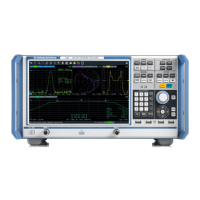Concepts and Features
R&S
®
ZNB/ZNBT
219User Manual 1173.9163.02 ─ 53
Meaning of S-parameters
The frequency-converting property of the mixer (i.e. the fact that incident and transmit-
ted waves are at different frequencies) causes a loss of phase information. While a
scalar measurement is active, the reverse transmission parameter S
12
is unavailable;
the magnitude of the forward transmission parameter S
21
describes the conversion
gain. The conversion gain measurement can be improved by a source match correc-
tion (included in the SMARTerCal) and a load match correction (optional). The phase
information, including the group delay, is meaningless.
In the scalar mixer mode the analyzer provides the following functionality:
●
Configuration of the RF and LO signals and measurement of the generated IF sig-
nal.
●
System error correction and power calibration of the signal sources and of the IF
receiver. A SMARTerCal is recommended for this purpose; see Chapter 5.7.4.1,
"Calibration Options", on page 218.
●
The mixer mode can be used to test important performance parameters of RF mix-
ers such as frequency ranges, conversion loss, compression, and isolation.
Two-Stage Mixer Measurements
The scalar mixer measurement is also suited for measuring a system of two mixers
with frequency multipliers at their RF and LO inputs. The RF and LO input frequencies
of the first mixer are both multiplied by an integer fraction; the converted output signal
f
int
is fed to the second mixer, together with the multiplied second LO signal. The ana-
lyzer measures the output signal of the second mixer at its IF input port. The general
test setup is shown below; the mixer system under test (MUT) is enclosed in a blue
rectangle.
The figure above also shows the possible output frequencies of the two mixers. The
actual values of f
int
and f
IF
depend on the RF and LO frequencies and of the measured
conversion (lower sideband or upper sideband with up- or down-conversion). The ana-
lyzer automatically calculates all frequencies and sets its receiver according to the set-
tings made.
A test setup with two mixers requires 3 independent source ports plus one receive port.
A R&S ZNB/ZNBT with two internal sources (see Chapter 5.7.8, "Internal Second
Source", on page 227) requires one external generator, all other R&S ZNB require two
external generators.
Optional Extensions and Accessories

